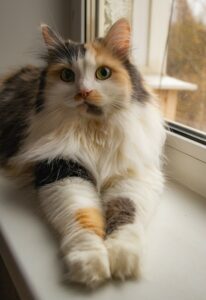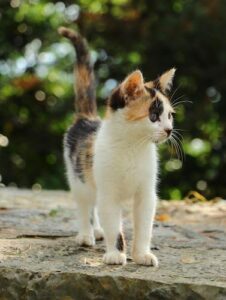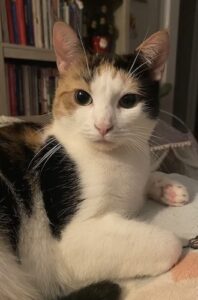 Calico does not refer to a specific cat breed but to a tri-color coat pattern, consisting of white, orange, and black. Calico cats can be domestic cats of any breed. The calico pattern is typically 25% to 75% white with large orange and black patches. Sometimes, patches can be cream or grey – a pattern referred to as a muted calico. The calico pattern should not be confused with that of a tortoiseshell cat. A tortoiseshell has a mostly mottled coat of black and orange or grey and cream with few to no white markings. Outside North America, however, the calico pattern is also called tortoiseshell and white.
Calico does not refer to a specific cat breed but to a tri-color coat pattern, consisting of white, orange, and black. Calico cats can be domestic cats of any breed. The calico pattern is typically 25% to 75% white with large orange and black patches. Sometimes, patches can be cream or grey – a pattern referred to as a muted calico. The calico pattern should not be confused with that of a tortoiseshell cat. A tortoiseshell has a mostly mottled coat of black and orange or grey and cream with few to no white markings. Outside North America, however, the calico pattern is also called tortoiseshell and white.
The description calico is taken from a colorful printed fabric by the same name. The calico fabric is originally from the city of Calicut in southwestern India and was brought to Europe by British imperial ships. From there, it was imported into the United States in the 1780s. In America, the meaning of the word calico changed. Instead of being the name of the fabric, calico was now used to describe the fabric’s unique color pattern and gradually became a common word in the descriptions of other things, too, including feline coat patterns.
 Calico cats are almost exclusively females because the calico pattern is linked to the feline X chromosome. Females have two X chromosomes, and female calicos have one coat color linked to each, which makes the black and orange patches possible. Calico males are therefore only seen in rare cases of genetic mutation, for instance when a male cat is born with two X chromosomes. This is called Klinefelter syndrome, and males with the XXY chromosome combination are usually sterile.
Calico cats are almost exclusively females because the calico pattern is linked to the feline X chromosome. Females have two X chromosomes, and female calicos have one coat color linked to each, which makes the black and orange patches possible. Calico males are therefore only seen in rare cases of genetic mutation, for instance when a male cat is born with two X chromosomes. This is called Klinefelter syndrome, and males with the XXY chromosome combination are usually sterile.
In addition to tortoiseshell and white, calico cats go by other names outside North America. In the province of Quebec in Canada, they are called chatte d’Espagne (French for ‘(female) cat of Spain’). Other names include brindle, tricolor cat, mikeneko (Japanese for ‘triple fur cat’), samsaek goyangi (Korean for ‘three colored cat’), and lapjeskat (Dutch for ‘patches cat’). Calicoes with diluted coloration are also called calimanco or clouded tigers.
 Calico cats are believed to bring good luck in the folklore of many cultures. In Germany, the word for a cat with calico coloring is Glückskatze or ‘lucky cat’, and in the United States, calicos are sometimes referred to as money cats. Similarly, Japanese Maneki-neko figures depict calico cats bringing good luck, and in the past, Japanese sailors often had a calico ship’s cat to protect them against misfortune at sea.
Calico cats are believed to bring good luck in the folklore of many cultures. In Germany, the word for a cat with calico coloring is Glückskatze or ‘lucky cat’, and in the United States, calicos are sometimes referred to as money cats. Similarly, Japanese Maneki-neko figures depict calico cats bringing good luck, and in the past, Japanese sailors often had a calico ship’s cat to protect them against misfortune at sea.
In the United States, the calico has been Maryland’s state cat since October 1, 2001. Calico cats were chosen as the Maryland cat because their white, black, and orange coloring resembles the coloring of the Baltimore oriole (the state bird) and the Baltimore checkerspot butterfly (the state insect).




